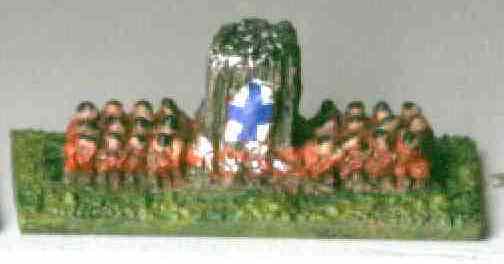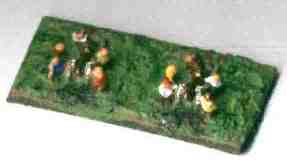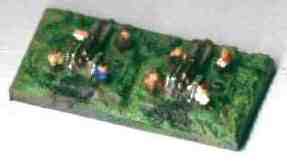|
[1450-1700] |
||||||||||||||||||||||||||||||||||||||
|
The rules for this variant were published in August 1993 in Wargames Illustrated [Issue 71]. The author was Stephen O'Leary who refers to an earlier set [published in WI 61 by Andrew Thomas] which I have not seen. They may be based on the original version [i.e. DBA 1 rather than DBA 1.1] but I doubt that it matters much. They came complete with extensive army lists, presumably converted from DBR. As an adaptation of the rules they work pretty well, possibly the best I have seen and used. Any DBA player could use these with only minimal reading of the modifications and glances at the tables during play, no major changes have been made. The alterations & additions fit well with the period, at least up to the end of the ECW, after that I'm not sure how well they 'fit', I know very little about that era. The only advice I would give is to avoid the optional rules, they complicate matters unnecessarily. |
||||||||||||||||||||||||||||||||||||||
|
There are 6 new troop types |
||||||||||||||||||||||||||||||||||||||
|
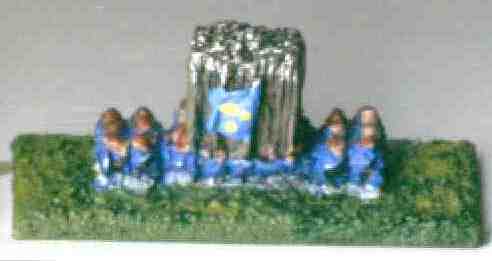 |
|||||||||||||||||||||||||||||||||||||
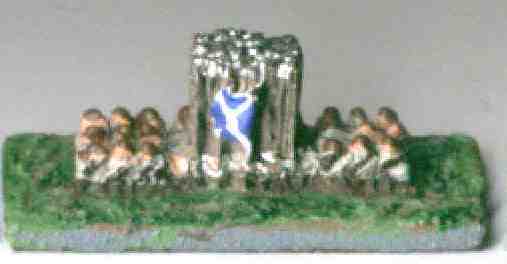 |
||||||||||||||||||||||||||||||||||||||
 |
||||||||||||||||||||||||||||||||||||||
|
The last 4 elements are collectively termed 'Firearms' and can shoot at a range of 200 paces. Reiters and Pike & Shot can not shoot. All the old types are still used but some now represent additional troop types as will become apparent on reading the army lists.
These new types are shown below with some suggestions for which blocks to use, basing colours and some illustrations of my painted elements. |
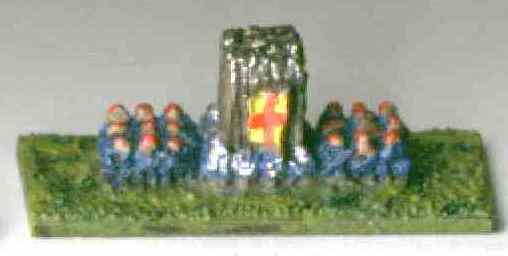 |
|||||||||||||||||||||||||||||||||||||
|
Pike & Shot [P&S] I never did work out why Irregular made so many different arrangements of Pike & Shot but they do allow a bit of variety in at least one type of element. Here are 5 of the 7 possible variants [RBG1 to 7]. They paint up quite well. Illustrated are (top down) RBG4, RBG5, RBG6, RBG2 & RBG3. |
|
|||||||||||||||||||||||||||||||||||||
| Pike & Shot [RBG3] | ||||||||||||||||||||||||||||||||||||||
|
Reiters [Re] Use either of the 2-rank cavalry [RBG17 & 19] for Reiters and paint early types in armour, later ones unarmoured. |
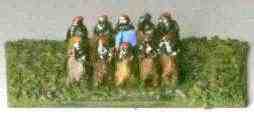 |
|||||||||||||||||||||||||||||||||||||
| Reiters | ||||||||||||||||||||||||||||||||||||||
|
Dragoons [Dg] Dragoons are made up from half a mounted dragoon block [RBG22] between the two parts of a cut up dismounted dragoon block [RBG11]. |
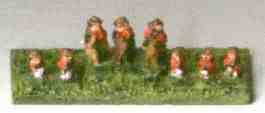 |
|||||||||||||||||||||||||||||||||||||
| Dragoons | ||||||||||||||||||||||||||||||||||||||
|
Arquebusiers [Aq] For Arquebusiers I use the 2-rank, loosely spaced bowmen [ABG24]. Don't use the option from the Ancient/Medieval DBA version to use this block as Crossbowmen if you think that you might get them confused even with different marking colours. |
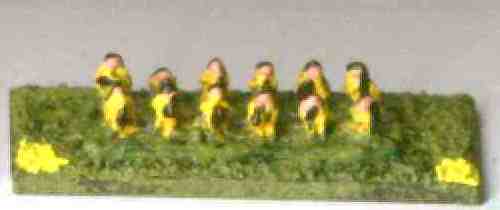 |
|||||||||||||||||||||||||||||||||||||
| Arquebusiers | ||||||||||||||||||||||||||||||||||||||
|
Musketeers [Mu] Use two forlorn hope [RBG12] side by side for Muskets, you could use a 2-rank block but my idea was to make them easily distinguishable from Bayonets. |
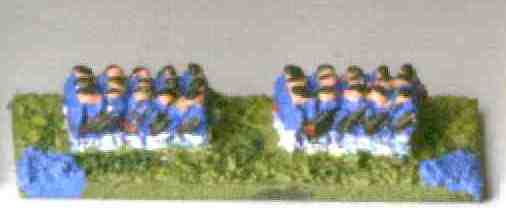 |
|||||||||||||||||||||||||||||||||||||
| Musketeers | ||||||||||||||||||||||||||||||||||||||
|
Bayonets [By] Use any of the 3-rank H&M infantry for Bayonets [BG2 or 15 or 16] |
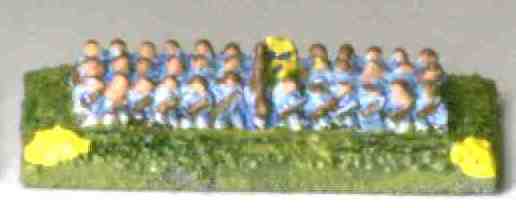 |
|||||||||||||||||||||||||||||||||||||
| Bayonets | ||||||||||||||||||||||||||||||||||||||
|
I have also used some other blocks to represent the existing DBA types for this period. These are optional alternatives |
||||||||||||||||||||||||||||||||||||||
|
Cavalry [Cv] I originally decided to use the 8 man cavalry blocks [RBG16, 18 & 19 or BG5] for Europeans and to stick with the various 6-man Ancient/Medieval types for non-Europeans. See also the note at the bottom of the table. |
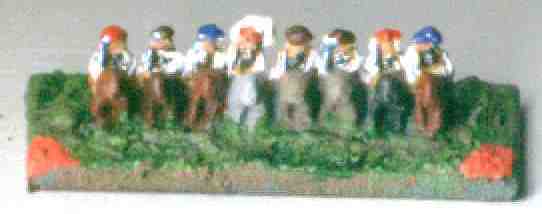
Cavalry |
|||||||||||||||||||||||||||||||||||||
|
Knights [Kn] Use RBG 13 or 14 but see note at bottom of table. |

Knights |
|||||||||||||||||||||||||||||||||||||
|
Light Horse [Lh] I use the Cossacks for lance armed LH such as Border Staves and Stradiots, Javelin armed for Genitors and Bow armed for most others. |
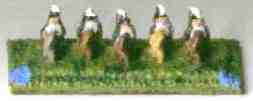
Light Horse |
|||||||||||||||||||||||||||||||||||||
|
Artillery [Ar] Use any combination of guns from the Renaissance range [RBG26 to 29] based in pairs. RBG29 is particularly impressive. |
Artillery
|
|||||||||||||||||||||||||||||||||||||
|
Psiloi [Ps] Most skirmishers were armed with either crossbows or firearms so the Dismounted Dragoons [RBG11] do well for this period though you could use the H&M skirmishers [BG3]. |

Psiloi |
|||||||||||||||||||||||||||||||||||||
|
Second Thoughts Having looked at the Humberside 1500-1900 variant, I may change my mind and use the 6-man cavalry blocks [RBG22 & 23 or BG4 & 11] for Cavalry and the 8-man blocks [RBG16, 18 & 20 or BG5] as later Knights (which represent hard charging horse such as Cuirassiers, Royalists and Swedes). This would be more consistent with the original basing. |
||||||||||||||||||||||||||||||||||||||
| Distinguishing troop types | ||||||||||||||||||||||||||||||||||||||
|
Telling one type of element from another or even which way an element is facing can be difficult during a battle and so I paint a coloured dot on the two front corners of the base. The colour is used to distinguish between different elements with similar appearance (e.g. Sp, Bd, By & Bw are all close order foot).
|
||||||||||||||||||||||||||||||||||||||
|
||||||||||||||||||||||||||||||||||||||
